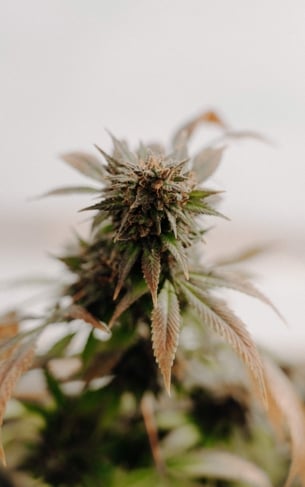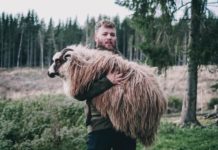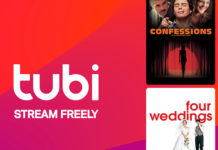
After the boom season of 2019, when planted hemp acreage in America went from 78,000 acres the year prior to half a million acres, the oversupply left some hemp farmers challenged, while others thrived. But whatever the year held for them, hemp farmers remain filled with a sense of passion, purpose, and love.
Big-picture people
Frances “Franny” Tacy is all about the love. She’s your cool cousin who does quirky things on that farm outside of town—you know, the place with “LOVE” painted on the barn that hosts baby goat yoga and is also a rustic Airbnb. Tacy is a former pharmaceutical exec (known then as “the hippie in high heels”) who turned rogue. She’s working with The Utopian Seed Project to reintroduce native crops to the Appalachians and bring back heritage strains of everything from okra to beans.
In 2017, she started growing hemp on Franny’s Farm, a 33-acre labor of love outside Asheville, NC. Today, she has half a dozen CBD dispensaries across four states—a savvy move given that health-promoting CBD is the hemp-derived ingredient people have been clamoring for.
“Our farm is this incubator for ideas that come to fruition that have never been done before,” says Tacy.
When Tacy switched gears in her career, from pharma to farm, she already had a farm in the rolling Appalachians. Western North Carolina is renowned as being one of the most biologically diverse areas of the country. So, reasoned Tacy, why not make deep ecological <and> social vitality possible by revitalizing American agriculture? Why shouldn’t hemp be the vessel through which community health would meet planetary health?
“It’s why I’m so in love with this plant,” Tacy enthuses. “Hemp fits the model … of sustainability and regenerative agriculture. It’s the only plant that we know of that can feed, clothe, shelter, and provide medicine.”
Tacy sees the big picture. Every hemp farmer I’ve talked with is like that. A certain esprit de corps. A definitive vision of a world filled with better alternatives.
Agriculture meets advocacy
Frederick Cawthon ditched his corporate management career in Tennessee but still wields his MBA like the whip of a lion tamer. He’s enticed investors, built a team of veteran growers, and convinced the local college president to open dormant summer dorms to house dozens of H-2A workers from Mexico to work an 85-acre hemp farm near Jackson, TN. He became president of the Tennessee chapter of the Hemp Industries Association to support the trade politically.
“Why are we getting licenses from the state to grow hemp?” Cawthon points out. “I don’t need a license to grow corn or soybeans or cotton.”
Colorado’s Michael Bowman also has dual roles as a farmer and an advocate. He planted his first hemp field in 2014 and quickly became an activist, lobbying Washington, D.C., officials to legalize hemp. Inside the corridors of power, he was dubbed “Mr. Hemp.”
Bowman says seed and chemical companies drive most decisions for corn and soybean farmers—what to plant; when to apply chemicals; where to deliver harvested crops.
“What is magic about this plant,” he says of hemp, “is it opens the right side of your brain. You start thinking about all the things you could do with it. You look at all the interesting products and great labels. People really feel more in charge, feel like they really can create with this plant. There’s very little option to do that with the traditional agriculture world.”
His son graduated from an agricultural school but didn’t hear the siren song of returning to the family farm in eastern Colorado—until Dad planted hemp.
“We’ve got to reinvent ourselves again in these rural areas,” says Bowman, who leads a partnership with 11 hemp farmers in Colorado and New Mexico and is also the founding chair of the U.S. Hemp Growers Association. “This is one way we can do it.”
What happens next?
Upstream, hemp farmers see the potential of hemp to nourish people, maintain family farms, and revitalize rural communities. Downstream, they see hemp’s capacity to disrupt every industry that builds everything in your house right now—from building materials and plastics to fuel and medicine. It’s all possible, and it all starts with hemp farmers’ love of their work.
“The feeling that you get out there brings me back to my childhood; it’s like being one with nature,” says Cawthon of the times when he gets out in the fields. “There’s a blessing in that silence, because you can think out there—and when you have your hands working on something, there’s a peace that comes from that.”
C of A: radical transparency for hemp CBD
A hemp CBD product might have a QR code on the label (or otherwise on its website) directing you to analytical test results showcasing quality—aka a certificate of analysis.
We spoke with Holly Johnson, PhD, chief science officer at the American Herbal Products Association, to get the inside scoop on how to interpret a certificate of analysis. (Call it a “C of A” if you want to use insider lingo.) These are her top tips.
- Check the date—is the report specific to the bottle in your hand or just an example of the types of testing the company generally performs?
- Look for “total THC” (also sometimes called “max THC” or “potential THC”)—this should be below 0.3 percent.
- Beware of “THC free” or “zero THC” claims. Such claims mean the TCH levels are too low to be detected in these tests, but this does not mean a drug test might not pick up any THC.
- Look for very little CBDA. CBDA can convert to CBD, but you want true, not potential, CBD.
CBD for stress and sleep
For many of us, ’tis the season when stress ramps up and sleep drops. The good news? Hemp CBD shows promise for soothing anxiety and sending us off to dreamland.
“CBD … has anxiolytic properties, particularly under circumstances or in response to stimuli which normally provoke anxiety,” note the authors of a 2019 paper on how cannabinoids help regulate fear and anxiety. While more studies are needed, the researchers posit that in the future, CBD could prove effective for anxiety-related disorders, especially when used in conjunction with traditional psychological therapy or other medication.
For those who are lying awake instead of dreaming of sugar plums (whatever those are), hemp CBD may come to the rescue. Keep in mind that research is mixed on CBD’s usefulness as a sleep aid—the effects seem to vary based on dose. In a 2017 review of literature on cannabinoids and sleep, the authors noted, “Low-dose CBD has a stimulating effect”—the opposite of what you want when you’re already struggling to fall asleep! “In comparison, medium- and high-dose CBD is sedating.” That’s more like it.
What’s the difference between full- and broad-spectrum hemp extracts?
While there’s some debate over these terms, in general, a broad-spectrum hemp extract has been processed to remove the THC, so there’s less than 0.01 percent THC in the finished product. In a full-spectrum extract hemp extract, none of the compounds have been completely removed.
Basically, a full-spectrum hemp extract will likely house a bit more THC than a broad-spectrum one, but both will be under the legal threshold of 0.3 percent THC, and both will contain CBD. The more important difference? A full-spectrum hemp extract will have the cannabinoids and aromatic terpenes in hemp, not just the select few present in broad-spectrum extracts. That’s because a full-spectrum hemp extract must “emulate the plant it came from, including all phytochemicals,” says Tim Gordon, board member of the Hemp Industries Association and the U.S. Hemp Growers Association.
Ethan Russo, MD, a leading CBD researcher, has posited that full-spectrum hemp is more potent as “a phytochemical factory” and thus has higher therapeutic value thanks to what has been called the “entourage effect.”
















